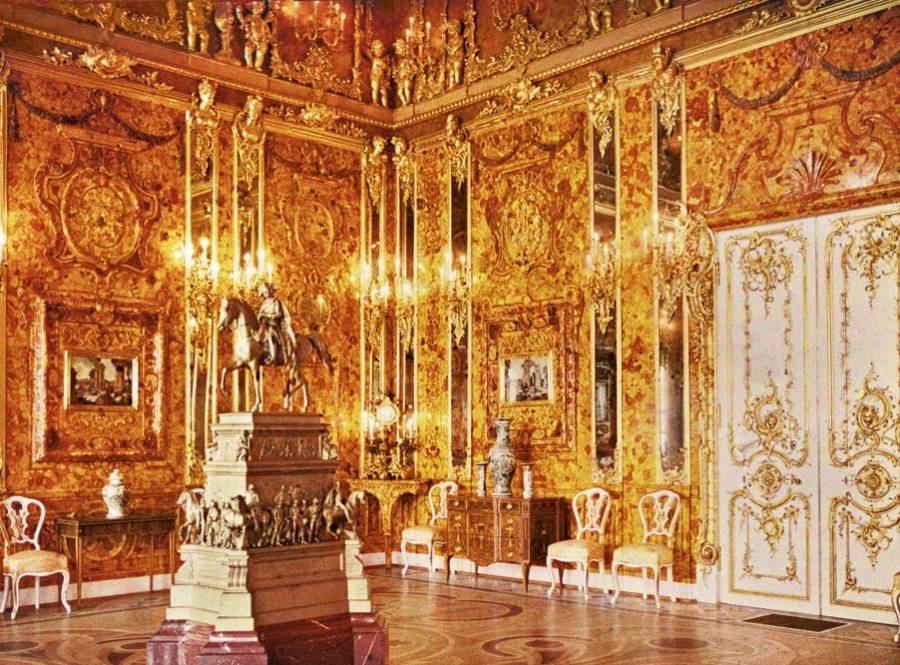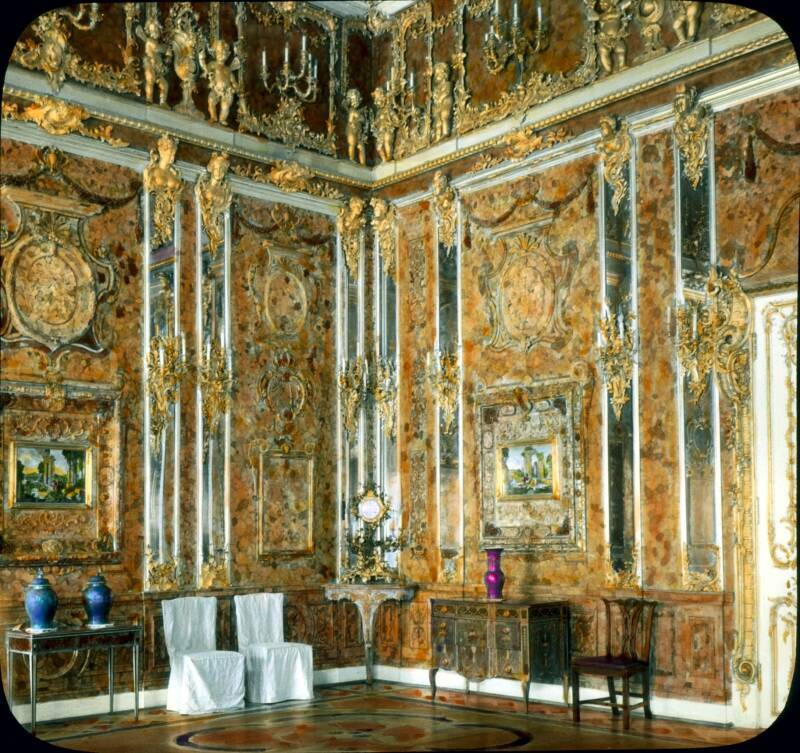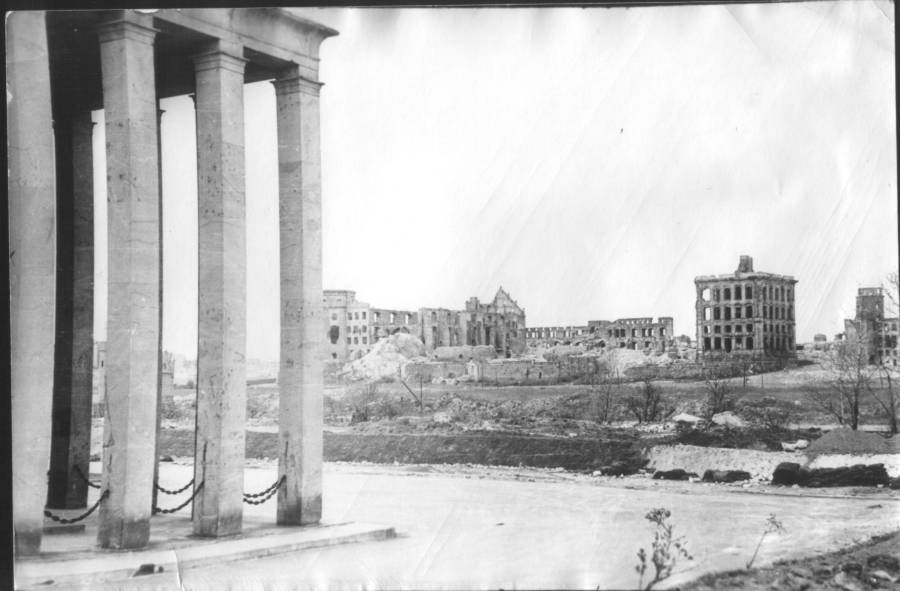Known as the "eighth wonder of the world," the Amber Room at the Catherine Palace in St. Petersburg was looted by the Nazis and disappeared forever in 1943.

Андрей Андреевич Зеест/Wikimedia Commons The Amber Room in 1917. This is the only known color picture of the original Amber Room.
The fate of the Amber Room in Catherine Palace outside of St. Petersburg, Russia, is one of Europe’s most enduring mysteries.
The Amber Room was once the jewel of the Romanov’s luxurious summer residence and was covered in amber, gems, and gold leaf from floor to ceiling. Estimated to be worth between $142 million and $500 million in today’s dollars, the room astonished visitors, who called it the “eighth wonder of the world.”
Then, during World War II, the Amber Room vanished after Nazi soldiers looted it. Because the room was originally built in Germany for the Prussian Emperor Frederick I and later gifted to Peter the Great of Russia, the Nazis claimed it was theirs.
But when they took it back to Germany, all records of its location disappeared. And while some claim that Allied bombs destroyed the precious historic room, others are certain that the Nazis must have hidden away its millions worth of amber. To this day, no one has ever found the amber room.
The Amber Room Was A Gift To Russia From Germany
Prussia’s first king, Frederick I, ordered the construction of the Amber Room in 1701. The room would stand as a testament to Prussian wealth. The king brought in sculptor Andreas Schlüter to design the room, while the Danish craftsman Gottfried Wolfram put together the delicate pieces.

Branson DeCou/UC Santa Cruz Special CollectionsA 1931 hand-tinted photograph of the original Amber Room.
The Baltic region contains some of the largest amber deposits in the world. And amber, fossilized tree resin dubbed the “gold of the north,” became a symbol of Prussian riches.
Not long after the Amber Room was completed at Charlottenburg Palace in Berlin in 1709, royals from across Europe expressed astonishment at its ingenuity. Kings had built rooms covered in gold and precious stones before. But no one had taken amber and transformed it into a glowing art installation.
And in addition to the multicolored amber set onto gold leaf panels to create intricate mosaics, the room was also decorated with mosaics of quartz, jasmine, jade, and onyx. In 2016, the original Amber Room was valued as high as $500 million.
But the room would not remain in Berlin for long. Frederick I died in 1712, and his son, Frederick William I, decided to gift the magnificent creation to the Russians in 1716 to commemorate their alliance against Sweden after Peter the Great spoke highly of the room during a visit to the palace.
So, only years after putting it together, Prussian artisans took apart the room and packaged up a fortune’s worth of amber in 18 boxes. The Russians recreated the display in the Winter Palace of St. Petersburg.
Skilled Craftsmen Expanded The Russian Amber Room
The Romanovs preened over their stunning room. In 1755, Peter the Great’s daughter, Empress Elizabeth, relocated the display to the Catherine Palace outside of St. Petersburg, where the family spent their summers.

Branson DeCou/UC Santa Cruz Special CollectionsThe original Amber Room as it looked in 1931 in a hand-tinted slide.
Now in a larger space, the Romanovs brought in an Italian designer to expand the Amber Room. Bartolomeo Francesco Rastrelli brought in more amber and crafted an even more impressive version of the room.
By the end of the 18th century, the room stood at around 180 square feet. It contained six tons of amber mixed in with other precious stones and gold leaf.
When Catherine the Great wanted to impress visitors, she hosted them in the Amber Room. And Czar Alexander II displayed his trophies in the room. Empress Elizabeth used the space for another purpose: private meditation.
In 1917, the Romanovs lost power in Russia. A revolution swept new rulers into power. And while much of the Romanov wealth disappeared, the Amber Room remained in the Catherine Palace — until the Nazis invaded Russia and stole the entire room.
How The Nazis Looted The ‘Eighth Wonder Of The World’
Hitler’s invasion of the Soviet Union — known as Operation Barbarossa — began in 1941. Three million Nazi soldiers flooded into the Eastern Front. And they hauled off a fortune in art, including the Amber Room.
With Nazis marching toward the Catherine Palace, Soviet officials tried to save the amber. But when they tried to take apart the intricate installations, the amber crumbled to pieces.

Wikimedia CommonsKönigsberg Castle as it looked in 1925, before Allied bombing destroyed the building during World War II.
That was, in part, because of how the craftsmen created the room. They heated fossilized tree resin and dunked it in honey and linseed. Then, artisans pressed the amber into wood panels. Centuries later, the dry amber had grown incredibly fragile.
Panicking, the officials put up wallpaper to hide the precious amber. But Nazi soldiers quickly saw through the deception. They took apart the room in a matter of hours and shipped it to Königsberg Castle.
The Nazis declared that the Amber Room was German. A German designer crafted it for a German king. And it should not remain in Russia.
In Königsberg, museum director Alfred Rohde looked after the artifacts. And when Allied advances threatened the castle in late 1943, Rohde packed away the amber. Then, in August 1944, a bomb hit the castle.
But did that bomb destroy the Amber Room? When the Soviets marched into Königsberg, they searched the rubble for the treasure. Yet no trace remained.
Has The Amber Room Ever Been Found?
No one has found the Amber Room since it vanished in 1943. But since its disappearance, many treasure hunters have clamored to discover the location of this lost horde, but none have been successful so far. So, what happened to the tons of amber worth millions?
One theory claims the bombings and fires destroyed the amber. A Soviet professor sent to investigate the missing artifacts claimed he found burned evidence of the amber mosaics in the Königsberg Castle cellar. But many refused to accept that explanation.

Terry Smith/The LIFE Images Collection/Getty ImagesA black and white photo of the original Amber Room.
Then in 1997, a clue emerged. The son of a Nazi soldier tried to sell a panel from the Amber Room at an auction in Germany. But a follow-up investigation showed that the panel was a one-off — his father stole just the single mosaic while removing the artifact from Russia.
One eyewitness claimed to see Nazis pack boxes onto a transport ship called the Wilhelm Gustloff. In the final months of the war, the Soviets sank the ship. Yet dives to the wreckage of the Wilhelm Gustloff have not turned up any evidence.
Another theory claimed the Nazis snuck out the boxes through tunnels under the castle. The amber may have been hidden away in underground salt mines, sunk to the bottom of a lagoon, or shipped overseas.
In 2017, three amateur sleuths, homeopath Leonhard Blume, 73, scientist Günter Eckardt, 67, and georadar specialist Peter Lohr, 71, thought they’d found the lost treasure. They believed that the famed room resided in Prince’s Cave in the Hartenstein hills near Dresden.
The cave is known to have been used by Nazi scientists, and Lohr told The Daily Mail that a “reliable source” told him in 2001 that the room was brought to an underground bunker there in 1945. And in fact, they even found evidence of a large bunker in these hills and a location where steel ropes were used to haul crates to their desired location.

Wikimedia CommonsKönigsberg Castle after it was bombed by the Allies.
But when they investigated, they came up empty-handed. No one else has found the Amber Room either.
And even if they had found it, Alexander Shedrinsky, a conservator and biochemistry professor at New York University, told The New York Times, it wouldn’t have been much to look at.
“If the Amber Room lies hidden somewhere, it is most probably in some damp mine, which means it is almost certainly in a state of ruin,” he said.
“Even before it was stolen, it was in poor shape, in need of restoration, and the amber pieces were falling out.”
Inside The Reconstructed Romanov Treasure
Today, the mystery of the Amber Room still has no solution — but one last theory holds that the Soviets themselves covered up the destruction of the room. After the war, Königsberg, Germany, became Kaliningrad, Russia, and in 1968, the Soviets destroyed the remains of Königsberg Castle, making it impossible for anyone else to find traces of the original room.

Antoine GYORI/Sygma via Getty ImagesThe reconstructed Amber Room in Catherine Palace in St. Petersburg opened on May 31, 2003 for the 300th anniversary of the city’s founding.
Then, in 1979, the Russians decided to rebuild the entire room. Using black and white photos of the Amber Room and uncovering the trade secrets necessary to create the multicolored amber of the room, the Russian government completed their recreation of the Amber Room in 2004.
The replica cost $11 million and marked the 300th anniversary of St. Petersburg. Ironically, when the organization tasked with recreating this landmark ran out of money in 2000, a German company raised the necessary funds to finish the project.
So a German-made artifact, given to the Russians, reworked by Russians and Germans, stolen by the German army, is finally recreated by the Russians with the help of a German company. The complicated relationship between these two great nations is embodied in the history of this work of art.
While visitors can view this new Amber Room in St. Petersburg, the original remains lost to history, at least for a while longer — until the original Amber Room may be found.
The Amber Room was only one of many treasures looted by the Nazis. Next, read about a fortune of silver hidden by the Nazis in a 14th-century Polish castle, and the Monuments Men, who saved priceless works of art and treasure from the Nazis.






